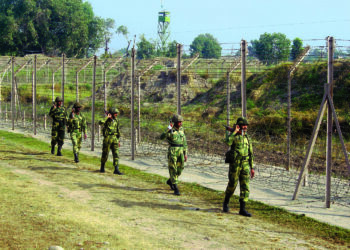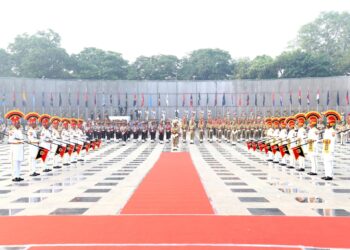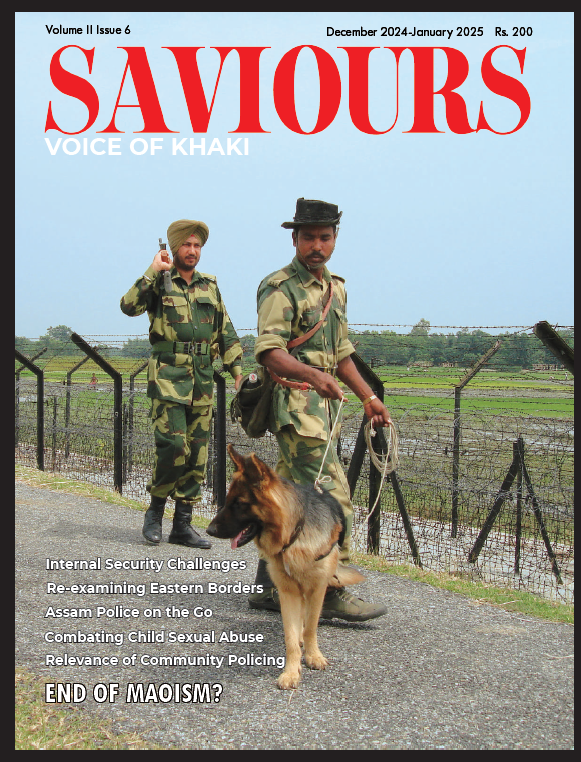Introduction: 
While considering India’s neighbourhood policy, there is often a tendency to discuss only bilateral issues and not analyse how much the leverage of superpowers influences South Asian reciprocal policies. Hence I shall begin my analysis with the impact of superpowers in our region and how it affects mutual relations with our neighbourhood.
Role of superpowers in our neighbourhood policy:
India and like-minded regional governments like Srilanka initially wanted to keep superpowers away from South Asia following the Neheruwian non-aligned policy. In the 1960s, Prime Minister Indira Gandhi started canvassing for declaring the Indian Ocean a zone of peace since the naval deployment of the US and Soviet Union in the Indian Ocean was causing regional tensions. However, Sri Lanka managed to get a United Nations General Assembly Resolution( 2832 XXVI) passed on 16 December 1971, which declared the Indian Ocean as a Zone of Peace together with the airspace above.
Following this, the late R.N.Kao, founder of our external intelligence, convinced France to give us technical help through his friendship with Le Comte Alexandre de Maranches, then the French external intelligence chief. He also persuaded Iran, then ruled by Shah Pahlavi, to join the “Trilateral Group” group in setting up a string of secret monitoring facilities on land and sea to keep a close watch on the naval movements of superpowers which would affect our security. However, the defeat of Mrs Indira Gandhi (1977) and the overthrow of the Shah in Iran(1978) caused changes in policies, and this arrangement had to be given up.
As long as the Soviet Union was actively mentoring Afghanistan till 1991, it benefited India since a friendly Kabul government did not allow anti-Indian predatory activities by Pakistan using Afghan soil. This forced Pakistan, even with American strategic support, to be watchful on their Western border, which reduced their intelligence and force deployment against India.
However, this situation drastically changed with the demise of the Soviet Union and also when India started supporting American naval presence in the renamed Indo-Pacific Ocean strategy(QUAD) to confront China, the rising superpower. Now our primary concern is China’s influence in South Asia and its efforts to “ring-fence” India strategically by using its financial clout through its Belt and Road Initiative(BRI).
Role of China in Influencing India’s Neighbours
From 2004 onwards, American researchers have cautioned India about China’s “String of Pearls” encirclement efforts. This came true in 2013 when Chinese President Xi Jinping unveiled his new global development strategy called “The Belt and Road Initiative” ( The Silk Road Economic Belt of the 21st Century Maritime Silk Road)
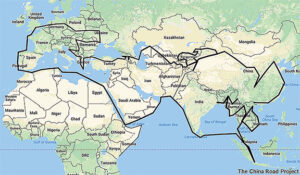 A Council on Foreign Relations (CFR) report on 24 March 2021 said that 139 countries had joined BRI. This has brought considerable policy dilemmas for India, the only one in the neighbourhood not to have joined it. Pakistan, Sri Lanka, Bangladesh, Nepal, Myanmar, and Afghanistan attended the May 2017 Belt and Road global conference among 1500 delegates from 130 countries including 29 Heads of state.
A Council on Foreign Relations (CFR) report on 24 March 2021 said that 139 countries had joined BRI. This has brought considerable policy dilemmas for India, the only one in the neighbourhood not to have joined it. Pakistan, Sri Lanka, Bangladesh, Nepal, Myanmar, and Afghanistan attended the May 2017 Belt and Road global conference among 1500 delegates from 130 countries including 29 Heads of state.
A 38-page assessment by the Council on Foreign Relations in June 2022 has mentioned the current US limitations in South Asia:
“The United States cannot match the BRI’s investments in South Asia, but it can support South Asian countries choosing to cooperate with China and India, the dominant power in the region. If the BRI delivers on its promise of providing connectivity and infrastructure in South Asian countries that sorely need both, it can contribute to domestic stability—a less volatile South Asia is in US interests.”
In sum, the US has left South Asia to fend for itself just as it had abandoned Afghanistan, resulting in a vast ungoverned area in this region, threatening to be a nursery for Islamic terrorism again, as it was during Osama bin Laden’s control of that country. The question is how far China would use this financial clout in our neighbourhood to checkmate India, which has pinned all its hopes on its QUAD membership for joint resistance against China. Prima facie, India with a defence budget of only US$ 76.2 billion cannot match China’s US$ 293 billion. Nor can India’s US$ 2.9 trillion GDP economy take on China’s 16.8 trillion GDP.
The above CFR paper cites the public perception of China in Pakistan. It says that the most recent Pew public opinion polls found that only 22% of Pakistanis trusted the United States whereas the “trust” factor in China was 82%. China has invested heavily in the China-Pakistan Economic Corridor (CPEC) with 4 schemes (a road-rail network connecting Pakistan-Xinjiang, energy projects, Gwadar port and 9 Economic zones). However, ethnic rivalries like the activities of Balochistan independence activists have caused set back for which both China and Pakistan continue to blame India. On 3 June 2019, “Open Democracy”, usually a reliable UK publication, carried a piece, “India and America collude to disrupt China-Pakistan Economic Corridor”, blaming R&AW and its proxies for attacks on Chinese engineers.
The indisputable fact is that, as pointed out by the CFR paper, ethnic tensions and “Pakistan’s pervasive corruption” have brought setbacks to the CPEC. Also, India’s protests against CPEC as it passes through the disputed territory of Kashmir have been twisted as efforts to sabotage the gigantic project.
In 2013 India(under the UPA government) welcomed the Chinese initiative in developing the BanglaDesh-China-India-Myanmar(BCIM)Economic corridor as it was felt that our North East would benefit if that corridor became successful. However, India became suspicious when China merged BCIM into BRI in 2015. At the same time, China has been fairly successful in wooing Bangla Desh, Sri Lanka & Maldives. China also extracted a favourable response from Bhutan to join BRI during the visit of Chinese Vice-Minister for foreign affairs Kong Xuanyou to Thimpu on 25 July 2018, although earlier Bhutan had followed India in not attending the 2017 Belt and Road global conference. This visit took place even after the 2017 Doklam stand-off between Indian and Chinese troops on Bhutanese territory at the trijunction between China-Bhutan-India was significant.
The CFR analysis says that “BRI has had the biggest success in Bangladesh, which not only perceives it positively but also has been able to manage the BRI and balance its geopolitical concerns about China and India, and received investment largesse from both”. Bangladesh has been successful in building up a close military relationship with China without annoying India -CFR paper says that 17% of Chinese military exports went to Bangla Desh between 2016 and 2020.
Mercator Institute for China Studies said that from 2010-2019, China became Bangladesh’s top source (72%) of military imports, behind only Pakistan. This paper says that the US exported US$ 110 million worth of arms to BanglaDesh- “a meagre amount compared to US$ 2.59 billion BanglaDesh has spent on Chinese military equipment”. Interestingly, China-BanglaDesh upgraded their relationship to a strategic partnership in 2016. Faced with this, the US was trying to upgrade BanglaDeshmilitary modernisation, starting with Apache helicopters and missiles.
At the same time, the Paris-based FIDH( Fédération internationale des ligues des droits de l’homme- International Federation for Human Rights) have been highlighting human rights violations in the CPEC projects as “BRI WATCH” circulars. Its bulletin for March 2022 dealt with several violations in Indonesia, Sri Lanka, Pakistan, Myanmar and Bangladesh. We have failed to capitalise on these allegations due to unknown reasons. Is it because our present government does not want to recognise global human rights organisations?
Specific analysis of our neighbours’ policies towards India
Among all our neighbours, the country to be closely watched is Bangladesh. This is not to say that Pakistan is less important; however, we know almost everything Pakistan would do against India’s interests. We are now fully prepared although we were caught napping before 26/11 due to our own faulty reading of intelligence pointers. This is also not to say that we should ignore developments in Sri Lanka, Maldives and Bhutan.

I would place Bangladesh on priority because of so many reasons. Presently we have excellent relations with the Awami League-led Bangladesh government. This is only because of Sheikh Hasina’s firm leadership as she is very grateful to India under the leadership of Mrs Indira Gandhi for freeing that country from Pakistan’s control and protecting her family at crucial times. However, it is anybody’s guess how far this goodwill will last, considering that country’s history, which alternated between antipathy and friendship in the past.
Firstly, Sheikh Hasina has managed her country skillfully, resulting in excellent economic results. Quoting IMF figures, the Bangladesh paper “Daily Star” claimed (14 October 2021) that it would surge ahead of India in terms of per capita GDP in the next five years (till 2026). It claimed that this trend had started in 2020 due to its continuous 6% annual growth with more remittances, exports and agriculture. Bangla Desh managed to grow even during the pandemic when other economies faltered. If it overtakes India, it is facile to expect Dhakka to play subservience to India.
Secondly, we should not forget that vast sections of Bangladesh are sympathetic to Pakistan only on religious grounds. Although the opposition parties, including the BNP, are vanquished, religious groups are getting stronger due to needless provocations from some BJP-ruled states in India where Muslims are perceived to be victimised. We should not forget that religious and familial bonds are stronger between Bangladesh Muslims and their brethren in the Eastern part of India than in the rest of India. Hence it is jarring for them to see their fellowmen of the same religion being called “illegals” despite possessing Indian citizenship. This was evident with the massive protest demonstrations by Hefazat-e-Islam Bangladesh (HIB-“safeguarding Islam in BanglaDesh”) against Prime Minister Narendra Modi during his visit to BanglaDesh on 26-27 March 2021.
HIB is unlike other Bangladeshi opposition parties and does not have a political charter. Yet it can mobilise thousands of unregulated Qawmi madrasas across the country, as in May 2013 when they collected more than a half million activists onto the streets and literally seized Dhakka with a 13-point charter. Prime Minister Sheikh Hasina’s government undoubtedly cracked down on the rally and killed at least 50 HIB activists.
As a result, Sheikh Hasina is “the most threatened” Prime Minister in the world. According to Economic Times, she had survived 19 assassination attempts in four decades. If she is removed from the scene, there is no guarantee that her successor will not be an Islamist. Even another Awami League leader may probably play footsie with ultra Right Islamist groups on populist considerations. We have to study that country’s history from 1977 when Gen.Zia ur-Rahman, who was once Mujibur Rahman’s follower, had dropped “secularism” from the Bangladesh constitution. The same was followed by Gen.Ershad in 1982 and Begum Khalida Zia from 1990 onwards.
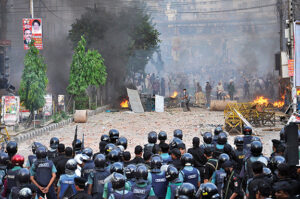 It will be advisable for Indian policymakers to read the masterly treatises “The Rise of Islamist Militancy in Bangladesh” written by Dr Sumit Ganguly for the United States Institute of Peace in 2006 and Bertil Lintner’s “Religious Extremism and Nationalism in Bangladesh” to understand how deep-rooted such extremists are in that country. Gen. Zia opened the doors for the dormant Islamists and “collaborators” (with Pakistan) to come to the mainstream after he seized power. In 1988 Ershad amended the constitution and made Islam the state religion. From then on, their intelligence service DGFI actively aided the return of hard-core Islamists hiding in Pakistan or Saudi Arabia. Harkat-ul-Jihad-al Islami and other extremist groups rose during that period. DGFI also aided our North East militants, like ULFA, Muslim Liberation Tigers etc., to launch operations against India by giving them sanctuaries. A seminar conducted by the Institute of Peace & Conflict Studies on 17 September 2007 confirmed this threat.
It will be advisable for Indian policymakers to read the masterly treatises “The Rise of Islamist Militancy in Bangladesh” written by Dr Sumit Ganguly for the United States Institute of Peace in 2006 and Bertil Lintner’s “Religious Extremism and Nationalism in Bangladesh” to understand how deep-rooted such extremists are in that country. Gen. Zia opened the doors for the dormant Islamists and “collaborators” (with Pakistan) to come to the mainstream after he seized power. In 1988 Ershad amended the constitution and made Islam the state religion. From then on, their intelligence service DGFI actively aided the return of hard-core Islamists hiding in Pakistan or Saudi Arabia. Harkat-ul-Jihad-al Islami and other extremist groups rose during that period. DGFI also aided our North East militants, like ULFA, Muslim Liberation Tigers etc., to launch operations against India by giving them sanctuaries. A seminar conducted by the Institute of Peace & Conflict Studies on 17 September 2007 confirmed this threat.
There is yet another reason why India should closely watch developments in Bangladesh. MERICS( Mercator Institute for China Studies) analysis dated 8 August 2022 has quoted that in 2014, the Pew Research survey had found 77 per cent of Bangladeshis viewing China positively, the highest positive rating for all countries, while only 43% preferred USA as an ally. India was seen as a potential threat. It also found that Bangladesh’s military and business leaders strongly advocate deeper Bangladesh-China relations.
BD Military planners see a convergence with China in strategic calculations as India “engulfs Bangladesh on three sides”, and hostile Myanmar shares the only other land border. In 2015, China replaced India as Bangladesh’s top trading partner, while India held that position for 40 years. Imports from China represented 34 per cent of Bangladesh’s total imports in 2019.
To conclude, we must closely watch the growing Chinese influence in our neighbourhood, which could threaten our national security and trade interests.



